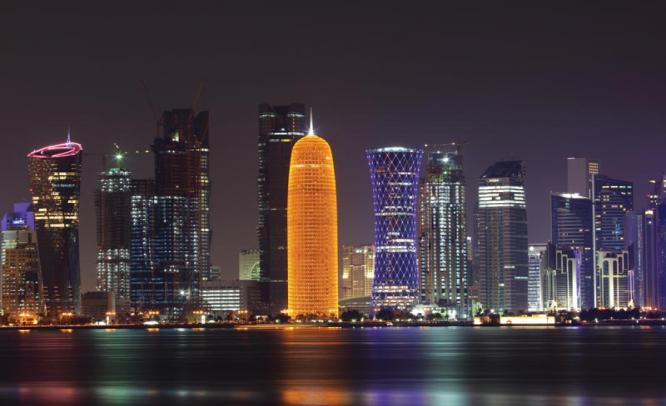The FIFA World cup is expected to draw around a half million visitors, which is almost a third of Qatar’s current population, the electrifying event at Qatar will have a major impact on the economy.
15th July 2013
Qatar is a peninsula in the Persian Gulf, about the size of Connecticut, sharing a border with Saudi Arabia. The sea side city of Doha is the capital and where most of the population resides, it’s a futuristic looking city where sky scrapers mingle together like pearls in a necklace, each one its own work of art, there is flow of money in the country mainly due to the construction boom. The country is also making strides towards improving its agricultural prowess, through a number of projects including solar power and desalination of sea water and using it for agricultural activities. The country is having an incentive, the Football World Cup is coming to Qatar in 2022, further fuelling the country’s urgency to develop quickly, it is the first country in the Middle East to get this honour. The FIFA World cup is expected to draw around a half million visitors, which is almost a third of Qatar’s current population, the electrifying event at Qatar will have a major impact on the economy.
The Government is on track with a large spending program, prior to the FIFA’s announcement, Qatar had already outlined a plan to spend around $ 100 billion, being 87 percent of GDP on infrastructure projects as a part of the country’s National Vision 2030, to develop and modernize the country. The hosting rights for the extravagant event have accelerated the infrastructure spending programme and can expect completion by 2022. As part of the infrastructural plan, government will spend more than $ 40 billion on projects and the remaining share will be funded by government entities such as Qatar Petroleum. The spending plan is expected to improve vital sectors such as transportation, tourism, health, education and housing sectors. The plan also includes a $ 25 billion metro and rail network. The construction of the New International Doha Airport is in the final phase, and replaces the current airport. The new airport would have the capacity to cater to 24 million passengers which is expected to handle 50 million passengers at a later stage. Other notable projects include the $ 7 billion deep water seaport and a $ 1 billion crossing to link the new airport to with northern Doha.
How would the World Cup help?
Hosting the World Cup adds a sense of urgency and provides stiffer deadlines for the completion of projects, critical to showcasing Qatar to the world, important projects such as Qatar-Bahrain causeway, have been given top priority. The causeway will be a huge boost to the economy as it will act as a vital trade link between Bahrain and Qatar, two of the largest financial centres in the Middle East. As per World Investment Report 2010, Qatar succeeded in more than doubling the value of FDI flows in a span of one year from $ 4.1 billion in 2008 to $ 8.8 billion last year, the credit lies with the country’s excessive Gas reserves and huge development in the energy sector, Qatar is currently ranked behind Saudi Arabia amongst the recipients of FDI. Apart from FDI, the banking and investment sector could be one of the main beneficiaries; the government backed projects have been very instrumental in helping the banking sector’s quick recovery in the aftermath of the global financial crisis. It would also strengthen the stock markets with some companies likely to go public for their funding; this in turn would improve the competitiveness of the region and would become the financial hubs for the region.
Economy
The latest data released by the country’s General Secretariat for Planning and Development, Doha showed the economy will grow at the rate of 5.3 percent in 2013, the latest forecast shows the emirate’s general economic slowdown, with 2012 GDP dropping to a growth rate of 6.2 percent from 18 percent in 2011. However, inflation in the Middle East country has dropped to 3.6 percent in 2013. As per an IMF data the country ranks top in the highest per capita GDP, which the IMF says is equivalent to $100,000 per person, but it might lose this advantage because its population is outgrowing its economy. Despite unfavourable political developments, wherein, Tamim bin Hamad al-Thani became the youngest monarch at 33, taking over the reins from his father and former ruler Sheikh Hamad bin Khalifa al-Thani, the economy remained stable and the bourse responded positively adding + 0.94 percent.
Major Role in Islamic Finance
“Qatar can be a major global platform for Islamic Finance in view of its resources, expertise in Shariah compliant products and services and world class regulatory framework” said Qatar International Islamic Bank, CEO, Abdulbasit A al-Shaibei. In an interview with the Gulf Finance, he said “Qatar has the resources, expertise, empowered regulators and manpower (human resources) in our country. We can build a much stronger platform for Islamic Finance in Qatar that can cater to, not just the region, but the whole world”.
Qatar is one of the first countries that identified the potential and importance of Islamic debt markets. In 2003, $ 700 million was raised for the sovereign through a seven year sukuk, which was joint lead managed by HSBC and QIIB.
Qatar’s current account balance is also expected to rise rapidly; in 2010 its current account balance was US $ 19.714 billion, increasing from 40.22 percent from 2009. By 2015, Qatar’s current account balance is anticipated to reach $ 42.21 billion. It has more than 15 percent of the world’s proven gas reserves and has ambitions to become a global energy giant; it is also active in the regional and world stage, having mediated its disputes in the Middle East and Africa.


